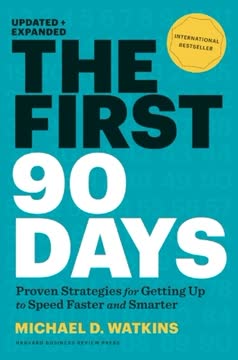Key Takeaways
1. Cybersecurity risk can be measured quantitatively, even with limited data
You have more data than you think and need less than you think, if you are resourceful in gathering data and if you actually do the math with the little data you may have.
Measurement is uncertainty reduction. Contrary to popular belief, cybersecurity risks can be quantified, even when data seems scarce. Measurement doesn't require perfect certainty, but rather a reduction in uncertainty based on available information. This shift in mindset opens up numerous possibilities for risk assessment.
Leveraging available data. Organizations often have more relevant data than they realize. This can include:
- Historical incident records
- System logs and performance metrics
- Industry breach statistics
- Expert knowledge and estimates
Simple techniques for limited data. Even with minimal data points, quantitative methods can provide valuable insights:
- Rule of Five: A 93.75% chance that a population median falls between the smallest and largest values in a random sample of five.
- Laplace's Rule of Succession: Estimating probabilities based on limited observations.
- Fermi decomposition: Breaking down complex estimates into more manageable components.
2. Overconfidence and cognitive biases hinder accurate risk assessment
There is no controversy in social science which shows such a large body of qualitatively diverse studies coming out so uniformly in the same direction as this one.
Humans are poor intuitive statisticians. Decades of research in decision psychology have consistently shown that humans, including experts, tend to be overconfident in their judgments and subject to various cognitive biases. This affects our ability to accurately assess risks and probabilities.
Common biases in cybersecurity risk assessment:
- Availability bias: Overestimating the likelihood of recent or memorable events
- Anchoring: Relying too heavily on initial information when making estimates
- Confirmation bias: Seeking information that confirms existing beliefs
- Overconfidence: Underestimating uncertainty and overestimating one's knowledge
Mitigating bias through structured approaches. To overcome these cognitive limitations, organizations should:
- Use formal, quantitative methods for risk assessment
- Provide training in calibrated probability estimation
- Encourage diverse perspectives and challenge assumptions
- Regularly test and update risk models based on new data
3. Calibrated probability estimates outperform intuition and qualitative methods
That is, when calibrated cybersecurity experts say they are 95% confident that a system will not be breached, there really is a 95% chance the system will not be breached.
The power of calibration. Calibrated probability estimates consistently outperform both expert intuition and qualitative risk assessment methods. Calibration training teaches individuals to express their uncertainty in terms of probabilities that accurately reflect real-world outcomes.
Benefits of calibrated estimates:
- Improved accuracy in risk assessment
- Clearer communication of uncertainty
- Better decision-making under uncertainty
- Ability to update beliefs systematically with new information
Calibration techniques:
- Trivia tests with feedback to improve probability assessments
- Equivalent bet test to gauge true confidence levels
- Practice with real-world scenarios and outcomes
- Regular recalibration to maintain skills
4. Decompose complex risks into measurable components for better analysis
If you find yourself making these calculations in your head, stop, decompose, and (just like in school) show your math.
Breaking down the problem. Complex cybersecurity risks can often be decomposed into smaller, more manageable components that are easier to estimate and measure. This approach allows for more accurate overall risk assessments and helps identify key drivers of uncertainty.
Decomposition strategies:
- Event trees: Breaking down scenarios into sequential events
- Fault trees: Analyzing potential causes of system failures
- Component analysis: Assessing individual system elements
- Factor analysis: Identifying key variables influencing risk
Benefits of decomposition:
- Improved accuracy in overall risk estimates
- Better understanding of risk drivers and dependencies
- Easier identification of data sources and measurement techniques
- More targeted risk mitigation strategies
5. Bayesian methods allow updating beliefs with new information
Information has value because we make decisions with economic consequences under a state of uncertainty.
Embracing uncertainty. Bayesian methods provide a powerful framework for updating beliefs and risk assessments as new information becomes available. This approach is particularly valuable in cybersecurity, where threats and vulnerabilities are constantly evolving.
Key Bayesian concepts:
- Prior probability: Initial belief based on existing knowledge
- Likelihood: Probability of observing evidence given a hypothesis
- Posterior probability: Updated belief after incorporating new evidence
Applying Bayes in cybersecurity:
- Updating threat probabilities based on new attack patterns
- Refining vulnerability assessments with patch effectiveness data
- Adjusting control efficacy estimates based on incident data
- Continuous improvement of risk models over time
6. Monte Carlo simulations provide powerful risk modeling capabilities
The authors have had many opportunities to apply every method described in this book in real organizations.
Beyond point estimates. Monte Carlo simulations allow for modeling complex systems with multiple uncertain variables. By running thousands of scenarios with randomly sampled inputs, these simulations provide a rich picture of potential outcomes and their probabilities.
Benefits of Monte Carlo in cybersecurity:
- Capturing the full range of potential outcomes
- Identifying low-probability, high-impact events
- Analyzing the combined effects of multiple risk factors
- Testing the sensitivity of results to different assumptions
Key steps in Monte Carlo simulation:
- Define the model and its parameters
- Specify probability distributions for uncertain inputs
- Generate random samples and run the model many times
- Analyze the distribution of results
7. Loss exceedance curves offer a clear visualization of cybersecurity risk
We can evaluate whether a given defense strategy is a better use of resources than another.
Communicating risk effectively. Loss exceedance curves provide a powerful visual tool for communicating cybersecurity risk to stakeholders. These curves show the probability of experiencing losses exceeding various thresholds, offering a clear picture of potential impacts.
Components of a loss exceedance curve:
- X-axis: Potential loss amounts
- Y-axis: Probability of exceeding each loss amount
- Curve shape: Steeper curves indicate higher risk
Using loss exceedance curves:
- Comparing different risk scenarios
- Evaluating the impact of security controls
- Setting risk tolerance levels
- Prioritizing risk mitigation efforts
8. Effective risk management requires ongoing measurement and improvement
We don't have to rely on calibrated estimates and subjective decompositions alone. Ultimately, we want to inform estimates with empirical data.
Continuous improvement cycle. Cybersecurity risk management is not a one-time effort but an ongoing process of measurement, analysis, and improvement. Organizations must regularly update their risk assessments and adapt their strategies as threats evolve and new data becomes available.
Key components of ongoing risk management:
- Regular data collection and analysis
- Updating risk models with new information
- Testing and refining risk mitigation strategies
- Monitoring key risk indicators and performance metrics
Building a data-driven culture:
- Establishing clear metrics and data collection processes
- Encouraging reporting and sharing of security-related data
- Investing in tools and training for data analysis
- Integrating risk data into decision-making processes
9. Organizational structure and culture are crucial for cybersecurity risk management
The CSRM function is a C-level function. It could be the CISO's function, but we actually put this role as senior to the CISO and reporting directly to the CEO or board.
Elevating cybersecurity risk. Effective cybersecurity risk management requires appropriate organizational structure and a culture that values data-driven decision-making. This often involves elevating the role of cybersecurity within the organization and integrating it with broader risk management and strategic planning efforts.
Key organizational considerations:
- Establishing a Chief Information Security Officer (CISO) or equivalent role
- Ensuring direct reporting lines to senior leadership
- Creating cross-functional teams for risk assessment and management
- Integrating cybersecurity into enterprise risk management frameworks
Fostering a risk-aware culture:
- Providing regular training and awareness programs
- Encouraging open communication about security risks
- Rewarding proactive risk identification and mitigation
- Leading by example with executive commitment to risk management
Last updated:
FAQ
What's How to Measure Anything in Cybersecurity Risk about?
- Focus on Measurement: The book emphasizes the importance of quantifying cybersecurity risks to improve decision-making. It critiques traditional qualitative methods and advocates for quantitative approaches.
- Quantitative Methods: Authors propose using probabilistic models and statistical methods to assess risks, enhancing the accuracy of risk assessments.
- Practical Tools: It provides frameworks and tools for cybersecurity professionals to implement effective risk measurement strategies in real-world scenarios.
Why should I read How to Measure Anything in Cybersecurity Risk?
- Improved Decision-Making: The book equips readers with the knowledge to make data-driven decisions, challenging reliance on intuition and qualitative assessments.
- Evidence-Based Approach: It presents research and case studies demonstrating the effectiveness of quantitative methods over traditional approaches.
- Practical Application: Includes templates and examples that can be directly applied in organizations to start measuring risks effectively.
What are the key takeaways of How to Measure Anything in Cybersecurity Risk?
- Measurement is Possible: The authors argue that everything, including intangible cybersecurity aspects, is measurable, leading to better resource allocation.
- Critique of Risk Matrices: The book critiques risk matrices for introducing confusion and errors, advocating for explicit probabilities and monetary impacts.
- Expert Calibration: Emphasizes training experts to improve probability assessments, leading to better risk management outcomes.
What are the best quotes from How to Measure Anything in Cybersecurity Risk and what do they mean?
- "We need more than technology.": Highlights the need for robust measurement and analysis methods alongside technology to mitigate risks.
- "There is no evidence that...risk matrix methods...improve judgment.": Critiques common risk assessment practices, suggesting they may lead to poor decision-making.
- "The human brain is a relatively inefficient device...": Emphasizes the limitations of human judgment, advocating for quantitative methods to enhance accuracy.
How does How to Measure Anything in Cybersecurity Risk define measurement in the context of cybersecurity?
- Uncertainty Reduction: Measurement is defined as a quantitatively expressed reduction of uncertainty based on observations.
- Probabilistic Approach: Advocates using probabilities to express uncertainty, providing a nuanced understanding of risks.
- Observable Outcomes: Effective measurement should be based on observable outcomes and data for informed decision-making.
What is the Rapid Risk Audit mentioned in How to Measure Anything in Cybersecurity Risk?
- Quick Assessment Tool: Designed to quickly assess significant cybersecurity risks within an organization, completed in a few hours.
- Structured Process: Involves identifying assets, threats, likelihoods, and impacts to generate a monetary estimate of potential losses.
- Excel Templates: Provides downloadable templates to facilitate the audit, making it accessible for immediate implementation.
What are the problems with risk matrices as discussed in How to Measure Anything in Cybersecurity Risk?
- Ambiguity and Confusion: Risk matrices often use ordinal scales that do not provide clear insights, leading to miscommunication.
- Range Compression Issues: Continuous values are reduced to discrete categories, resulting in information loss and misclassification.
- Lack of Effectiveness: No evidence supports that risk matrices improve judgment, suggesting they may do more harm than good.
How can experts improve their probability assessments according to How to Measure Anything in Cybersecurity Risk?
- Calibration Training: Training helps experts assess probabilities more accurately, reducing overconfidence and improving judgment.
- Feedback Mechanisms: Regular feedback on past estimates refines skills and consistency in assessments.
- Structured Methods: Using structured methods, like breaking down complex estimates, leads to more accurate outcomes.
What is the Exsupero Ursus fallacy mentioned in How to Measure Anything in Cybersecurity Risk?
- "Beat the Bear" Fallacy: Refers to flawed reasoning of defaulting to another method without considering its flaws.
- Comparison of Methods: Emphasizes comparing weaknesses of alternatives to ensure better decision-making.
- Critical Evaluation: Highlights the need for evidence-based evaluation of all risk assessment methods.
How does How to Measure Anything in Cybersecurity Risk suggest decomposing risks for better measurement?
- Clear, Observable, Useful: Decompositions should be specific, measurable, and useful for decision-making.
- Focus on Relevant Factors: Leverage organizational knowledge for precise estimates of likelihood and impact.
- Avoid Over-Decomposition: Warns against speculative estimates, focusing on well-understood, measurable factors.
What is the "beta distribution" and how is it used in How to Measure Anything in Cybersecurity Risk?
- Modeling Probabilities: A statistical tool for modeling probabilities between 0 and 1, useful for limited data.
- Updating Beliefs: Allows for refining probability estimates with new information, improving risk assessments.
- Practical Applications: Applied to real-world scenarios, like estimating data breach likelihoods, valuable for professionals.
How does How to Measure Anything in Cybersecurity Risk suggest integrating cybersecurity risk management with enterprise risk management?
- C-Level Function: Proposes CSRM as a C-level function, elevating its importance within the organization.
- Quantitative Assessment: Focuses on quantitative assessments of technology risks for better resource allocation.
- Collaboration Across Departments: Emphasizes collaboration with finance and legal for a holistic risk management approach.
Review Summary
Readers generally find How to Measure Anything in Cybersecurity Risk insightful, praising its quantitative approach to risk assessment. Many appreciate the book's emphasis on statistical methods and data-driven decision-making in cybersecurity. Critics note that some concepts may be challenging for those without a strong math background. While some reviewers found the book repetitive or overly focused on criticizing existing methods, others valued its practical examples and guidance for improving risk management practices. Overall, the book is widely recommended for cybersecurity professionals seeking to enhance their risk assessment strategies.
Similar Books










Download PDF
Download EPUB
.epub digital book format is ideal for reading ebooks on phones, tablets, and e-readers.







